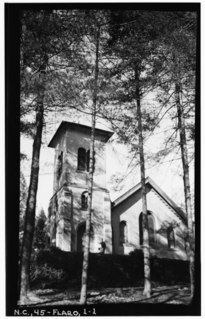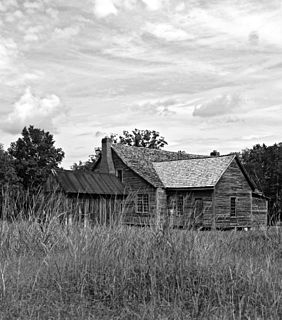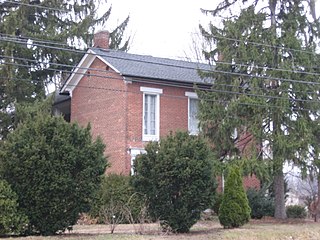
Leland Castle is a building in New Rochelle, New York. It was constructed during the years in 1855 - 1859 in the Gothic Revival style, and was the country residence of Simeon Leland, a wealthy New York City hotel proprietor. Leland began to assemble an estate as early as 1848, and in 1855, began the erection of this palatial 60-room mansion. The home was designed by New York City architect William Thomas Beers. A north and south wing were added to the castle in 1899 and 1902 respectively.

Flat Rock Historic District is a national historic district located at Flat Rock, Henderson County, North Carolina. The district encompasses 55 contributing buildings and 1 contributing site associated with estates centering on the ambitious summer houses of the prominent Charlestonians. The homes includes notable examples of Stick Style / Eastlake movement, Second Empire, and Gothic Revival residential architecture. Located in the district is the separately listed Carl Sandburg Home National Historic Site, also known as Connemara. Other notable estates include Mountain Lodge, Argyle, Beaumont, Tall Trees (Greenlawn), Many Pines, Chanteloupe, Teneriffe, Rutledge Cottage, Dunroy, Treholm-Rhett House home of George Trenholm, Kenmure (Glenroy), Vincennes home of William Elliott, Sallie Parker House, Enchantment, Bonclarken (Heidleberg), Saluda Cottages, Tranquility, and the Rhue House. Also located in the district is St. John-in-the-Wilderness church and rectory, the Old Post Office, Woodfield Inn, The Lowndes Place.

Church of the Transfiguration is a historic Episcopal church located at Henderson and Charles Streets in Saluda, Polk County, North Carolina. It was built in 1889, and is a one-story Carpenter Gothic-style church with a steeply pitched gable roof and board and batten siding. It features a two-tiered square corner bell tower and pointed arch stained glass windows. A vestry addition was built in 1968.

Spann Methodist Church and Cemetery is a historic Methodist church and cemetery located at 150 Church Street in Ward, Saluda County, South Carolina. It was built in 1873, and is a one-story, frame meeting house form church with Greek Revival style elements. The front facade features an engaged tetrastyle portico with a pedimented gable roof. The cemetery was established about 1842, and includes a significant collection of funerary art dating to the late-19th and early-20th centuries.

Henry House is a two-and-a-half-storey stone house located on Barrington Street in Halifax, Nova Scotia, Canada. The house is designated a National Historic Site, and is both a Provincially Registered Property and a Municipally Registered Property under the provincial Heritage Property Act.

Cartledge House is a historic home located at Batesburg-Leesville, Lexington County, South Carolina. It was built about 1898, and is a two-story, Victorian-era weatherboard dwelling. It consists of a rectangular central block under a hipped roof with sheet metal shingles and a truncated ridge. Double gallery porches wrap around the front and side elevations on both stories ornamented by Tuscan order colonettes and turned balustrades. The front roof slope features a steep cross gable pierced by a circular vent.

Charlton Rauch House is a historic home located at Lexington, Lexington County, South Carolina. It was built in 1886, and is a 2 1/2- story, frame vernacular Queen Anne style house with an irregular plan and a gable roof. It is sheathed in weatherboard and has a one-story rear wing. the front façade features a one-story, hip roofed porch with a second-story, shed-roofed porch; a two-story polygonal bay; and a hip-roofed, three-story, projecting polygonal bay. Its owner Charlton Rauch operated a livery stable and was a cotton buyer and dealer in general merchandise.

Webb-Coleman House, also known as Christian's Post Office, is a historic home located near Chappells, Saluda County, South Carolina. It was built between 1800 and 1825, and is a 2 1/2-story, five-bay, Federal style farmhouse. It has a gable roof and is sheathed in weatherboard. A one-story, frame wing was added in the mid-19th century and in 1915, a one-story, gable-roofed, frame ell and shed-roofed porch. Also on the property are the contributing mid-to late-19th century cotton house, an early-20th century garage, an early 1930s dollhouse, and an early-20th century tenant house. The house operated as a post office from 1833–1844.

Bonham House, also known as Flat Grove, is a historic home located near Saluda, Saluda County, South Carolina. It was built about 1780, and is a two-story, log "dogtrot house." The house sits on fieldstone pillars. It was the boyhood home of Battle of the Alamo soldier James Bonham and his brother politician Milledge Luke Bonham, who served as governor of South Carolina during the American Civil War.

Marsh-Johnson House, also known as Robert Johnson House, is a historic home located near Saluda, Saluda County, South Carolina. It was built about 1817, and is a two-story, log farmhouse sheathed in weatherboard. The house sits on a brick foundation and has a one-story, shed-roofed porch. It is considered one of the earliest and intact log residences in South Carolina.

Building at 303 Saluda Avenue, also known as John C. Heslep House, is a historic home located at Columbia, South Carolina. It was built about 1917 as a two-story brick residence, then remodeled and rebuilt in the Spanish Colonial Revival style in 1927–1928. It features a low-pitched tile roof, coarse stucco walls, and cast iron balconies. Also on the property is a contributing guest house.

Robert L. Doughton House is a historic home located at Laurel Springs, Alleghany County, North Carolina It was built in 1899, and is a two-story frame farmhouse in a vernacular Queen Anne style influenced frame cottage. It features a steeply pitched hip roof, with a two-story, one-bay gable roof projection. It was the home of Robert L. Doughton (1863-1954), one of North Carolina's foremost politicians of the first of the 20th century. In the 1990s Rufus A. Doughton's house was restored, and it is now a popular bed-and-breakfast for tourists to the region.

Glendale Springs Inn is a historic hotel building located at Glendale Springs, Ashe County, North Carolina. It was built in 1895, and expanded in 1902. A wing was added in 1905. It is a two-story, "T"-plan, frame structure with a steeply pitched intersecting gable roofs and sheathed in plain white weatherboard. It features a wraparound porch and second story balconies. It housed a vacation resort and inn for guests visiting the mineral waters at Glendale Springs. From 1935 to 1938, the inn housed the Works Progress Administration headquarters during construction of the nearby Blue Ridge Parkway. The building was renovated in 1975 with a Family Style Restaurant, underwent subsequent renovations in 1995, and now houses a bed and breakfast inn.

Patrick St. Lawrence House, also known as the Yellow House, is a historic home located at Pittsboro, Chatham County, North Carolina. It was built about 1787, and is a two-story, five bay, Federal / Greek Revival style frame dwelling with a low gable roof. It was originally built as an inn and overlooked the courthouse square. It is Pittsboro's oldest building. It was moved to its present site in 1955.

Sunny Side Inn, also known as the Sunny Side Oyster Bar, is a historic oyster bar located at Williamston, Martin County, North Carolina. The original section was built in 1929 as a one-story, gable front frame building housing the Sanitary Service Market. It was enlarged in 1930–1931 with the addition of a front gable room for a lunch room and a rear addition housing the oyster bar was built between 1935 and 1940. The building is sheathed in weatherboard and has American Craftsman-style exposed roof rafters.

Railway Clerks' Mountain House, also known as the Mountain Home, Clerks' Mountain Home, and Orchard Inn, is a historic country inn located near Saluda, Polk County, North Carolina. The inn ("home") was built in 1926, and is a two-story, six bay, frame building with Colonial Revival and American Craftsman style design influences. It has a hipped roof and features a full width hip-roofed one-story porch supported by slender Tuscan order columns. Also on the property are three contributing guest cottages built about 1926: the "Paulownia" Cottage, "Boxwood" Cottage, and "Twin Poplar" Cottage. The property was originally developed by the Brotherhood of Railway Clerks of the Southern Railway System as a summer retreat. The union retained the property until 1962.

Ryder Hall, also known as the Mountain Manor Hotel and Cloud Hotel, is a historic hotel located at Saluda, Polk County, North Carolina. It was built in 1909, as a girls' dormitory for the Saluda Seminary that operated until 1922. It is a 2+1⁄2-story, "H"-plan, Colonial Revival style frame building sheathed in weatherboard. It has a gambrel roof with shed-roof dormers and features full-width one-story shed roof porches on the front and rear elevations. It housed a public school until 1927, then was converted to a hotel. It was converted to a single-family dwelling after 1992.

Pine Gables, also known as Logan House and Harris Inn, is a historic inn complex and national historic district located near Lake Lure, Rutherford County, North Carolina. The property encompasses 10 contributing buildings, 5 contributing sites, and 3 contributing structures. The original log sections of the inn dates to about 1800, and enlarged and modified in 1834, 1877, and 1924. It is a 2 1/2-story, frame building with high pitched gables in a vernacular Queen Anne style. Also on the property are the contributing Old Tearoom now used as a single family dwelling, a one-story stone structure, seven guest cabins, a craft shop, rock wall, three ponds, a segment of Old Highway 20, and the shoreline of Lake Lure. Judge George Washington Logan (1815-1889), who also owned the George W. Logan House at Rutherfordton, bought the inn in 1866 and it became known as the "Logan House". During the Great Depression, the inn and surrounding property was used to promote economic recovery as a Civilian Conservation Corps (CCC) headquarters.

Aston Inn, also known as the Ratner Residence, is a historic inn located at Indianapolis, Marion County, Indiana. It was built in 1852, and is a two-story, Greek Revival style brick dwelling with an early one-story addition. It has a side gable roof and features a two-story gallery on the south elevation. The house was used as a stagecoach stop for a short period in the 1850s.

The Sheldon Boright House, also known as the Grey Gables, is a historic house at 122 River Street in Richford, Vermont. Built in 1890 for a prominent local businessman, it is a fine example of a pattern-book design by Palliser, Palliser & Company, and may be the only instance of a house found on the cover of one of that company's pattern books. Now a bed and breakfast inn, it was listed on the National Register of Historic Places in 1989.
























